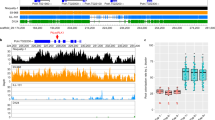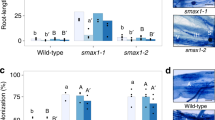Abstract
Most higher plant species can enter a root symbiosis with arbuscular mycorrhizal fungi, in which plant carbon is traded for fungal phosphate1,2. This is an ancient symbiosis, which has been detected in fossils of early land plants3. In contrast, the nitrogen-fixing root nodule symbioses of plants with bacteria evolved more recently, and are phylogenetically restricted to the rosid I clade of plants4. Both symbioses rely on partially overlapping genetic programmes5,6. We have identified the molecular basis for this convergence by cloning orthologous SYMRK (‘symbiosis receptor-like kinase’) genes from Lotus and pea, which are required for both fungal and bacterial recognition. SYMRK is predicted to have a signal peptide, an extracellular domain comprising leucine-rich repeats, a transmembrane and an intracellular protein kinase domain. Lotus SYMRK is required for a symbiotic signal transduction pathway leading from the perception of microbial signal molecules to rapid symbiosis-related gene activation. The perception of symbiotic fungi and bacteria is mediated by at least one common signalling component, which could have been recruited during the evolution of root nodule symbioses from the already existing arbuscular mycorrhiza symbiosis.
This is a preview of subscription content, access via your institution
Access options
Subscribe to this journal
Receive 51 print issues and online access
$199.00 per year
only $3.90 per issue
Buy this article
- Purchase on Springer Link
- Instant access to full article PDF
Prices may be subject to local taxes which are calculated during checkout




Similar content being viewed by others
References
Harrison, M. J. Molecular and cellular aspects of the arbuscular mycorrhizal symbiosis. Annu. Rev. Plant Physiol. Plant Mol. Biol. 50, 361–389 (1999)
Rausch, C. et al. A phosphate transporter expressed in arbuscule-containing cells in potato. Nature 414, 462–470 (2001)
Remy, W., Taylor, T. N., Hass, H. & Kerp, H. Four hundred-million-year-old vesicular arbuscular mycorrhizae. Proc. Natl Acad. Sci. USA 91, 11841–11843 (1994)
Soltis, D. E. et al. Chloroplast gene sequence data suggest a single origin of the predisposition for symbiotic nitrogen-fixation in angiosperms. Proc. Natl Acad. Sci. USA 92, 2647–2651 (1995)
Duc, G., Trouvelot, A., Gianinazzi-Pearson, V. & Gianinazzi, S. First report of non-mycorrhizal plant mutants (myc-) obtained in pea (Pisum sativum L.) and fababean (Vicia faba L.). Plant Sci. 60, 215–222 (1989)
Wegel, E., Schauser, L., Sandal, N., Stougaard, J. & Parniske, M. Mycorrhiza mutants of Lotus japonicus define genetically independent steps during symbiotic infection. Mol. Plant-Microbe Interact. 11, 933–936 (1998)
Szczyglowski, K. et al. Nodule organogenesis and symbiotic mutants of the model legume Lotus japonicus. Mol. Plant-Microbe Interact. 11, 684–697 (1998)
Schauser, L. et al. Symbiotic mutants deficient in nodule establishment identified after T-DNA transformation of Lotus japonicus. Mol. Gen. Genet. 259, 414–423 (1998)
Bonfante, P. et al. The Lotus japonicus LjSym4 gene is required for the successful symbiotic infection of root epidermal cells. Mol. Plant-Microbe Interact. 13, 1109–1120 (2000)
Downie, J. A. & Walker, S. A. Plant responses to nodulation factors. Curr. Opin. Plant Biol. 2, 483–489 (1999)
Schauser, L., Roussis, A., Stiller, J. & Stougaard, J. A plant regulator controlling development of symbiotic root nodules. Nature 402, 191–195 (1999)
Heidstra, R., Nilsen, G., Martinez-Abarca, F., van Kammen, A. & Bisseling, T. Nod factor-induced expression of leghemoglobin to study the mechanism of NH4NO3 inhibition on root hair deformation. Mol. Plant-Microbe Interact. 10, 215–220 (1997)
Sato, S. et al. Structural analysis of a Lotus japonicus genome. I. Sequence features and mapping of fifty-six TAC clones which cover 5.4 Mb of the genome. DNA Res. 8, 311–318 (2001)
Cullimore, J. V., Ranjeva, R. & Bono, J. J. Perception of lipo-chitooligosaccharidic Nod factors in legumes. Trends Plant Sci. 6, 24–30 (2001)
Shiu, S. H. & Bleecker, A. B. Receptor-like kinases from Arabidopsis form a monophyletic gene family related to animal receptor kinases. Proc. Natl Acad. Sci. USA 98, 10763–10768 (2001)
Jones, D. A. & Jones, J. D. G. The role of leucine-rich repeat proteins in plant defences. Adv. Bot. Res. 24, 89–167 (1997)
Catoira, R. et al. Four genes of Medicago truncatula controlling components of a nod factor transduction pathway. Plant Cell 12, 1647–1665 (2000)
Walker, S. A., Viprey, V. & Downie, J. A. Dissection of nodulation signalling using pea mutants defective for calcium-spiking induced by Nod-factors and chitin oligomers. Proc. Natl Acad. Sci. USA 97, 13413–13418 (2000)
Wais, R. J. et al. Genetic analysis of calcium spiking responses in nodulation mutants of Medicago truncatula. Proc. Natl Acad. Sci. USA 97, 13407–13412 (2000)
Schneider, A. et al. Genetic mapping and functional analysis of a nodulation-defective mutant (sym19) of pea (Pisum sativum L.). Mol. Gen. Genet. 262, 1–11 (1999)
Turner, S. R., Hellens, R., Ireland, R., Ellis, N. & Rawsthorne, S. The organization and expression of the genes encoding the mitochondrial glycine decarboxylase complex and serine hydroxymethyltransferase in pea (Pisum sativum). Mol. Gen. Genet. 236, 402–408 (1993)
Ehrhardt, D. W., Wais, R. & Long, S. R. Calcium spiking in plant root hairs responding to Rhizobium nodulation signals. Cell 85, 673–681 (1996)
Duc, G. & Messager, A. Mutagenesis of pea (Pisum sativum L.) and the isolation of mutants for nodulation and nitrogen fixation. Plant Sci. 60, 207–213 (1989)
van Spronsen, P. C., Gronlund, M., Paciaos Bras, C., Spaink, H. P. & Kijne, J. W. Cell biological changes of outer cortical root cells in early determinate nodulation. Mol. Plant-Microbe Interact. 14, 839–847 (2001)
Firmin, J. L., Wilson, K. E., Carlson, R. W., Davies, A. E. & Downie, J. A. Resistance to nodulation of cv. Afghanistan peas is overcome by nodx, which mediates an O-acetylation of the Rhizobium leguminosarum lipo-oligosaccharide nodulation factor. Mol. Microbiol. 10, 351–360 (1993)
Acknowledgements
We thank A. Downie and D. Bradley for comments on the manuscript, A. Serna-Sanz for supplying nod-factor preparations, C. Pacios Bras and H. Spaink for making available M. loti R7A carrying lacZ, C. Ronson for providing the M. loti NodC mutant, A. Edwards and C. Martin for help with Pisum libraries, and V. Viprey for the gift of Pisum and Medicago cDNA. We thank M.-A. Torres for structure prediction. C.K. was supported by a postdoctoral fellowship from the DFG (Deutsche Forschungsgemeinschaft). Research at the Sainsbury Laboratory is funded by the Gatsby Charitable Foundation.
Author information
Authors and Affiliations
Corresponding author
Ethics declarations
Competing interests
The authors declare that they have no competing financial interests.
Rights and permissions
About this article
Cite this article
Stracke, S., Kistner, C., Yoshida, S. et al. A plant receptor-like kinase required for both bacterial and fungal symbiosis. Nature 417, 959–962 (2002). https://doi.org/10.1038/nature00841
Received:
Accepted:
Issue Date:
DOI: https://doi.org/10.1038/nature00841
This article is cited by
-
Innovations in functional genomics and molecular breeding of pea: exploring advances and opportunities
aBIOTECH (2024)
-
A rare non-canonical splice site in Trema orientalis SYMRK does not affect its dual symbiotic functioning in endomycorrhiza and rhizobium nodulation
BMC Plant Biology (2023)
-
Comparative phylotranscriptomics reveals ancestral and derived root nodule symbiosis programmes
Nature Plants (2023)
-
Role of Nod factor receptors and its allies involved in nitrogen fixation
Planta (2023)
-
Rhizobia induce SYMRK endocytosis in Phaseolus vulgaris root hair cells
Planta (2023)
Comments
By submitting a comment you agree to abide by our Terms and Community Guidelines. If you find something abusive or that does not comply with our terms or guidelines please flag it as inappropriate.



